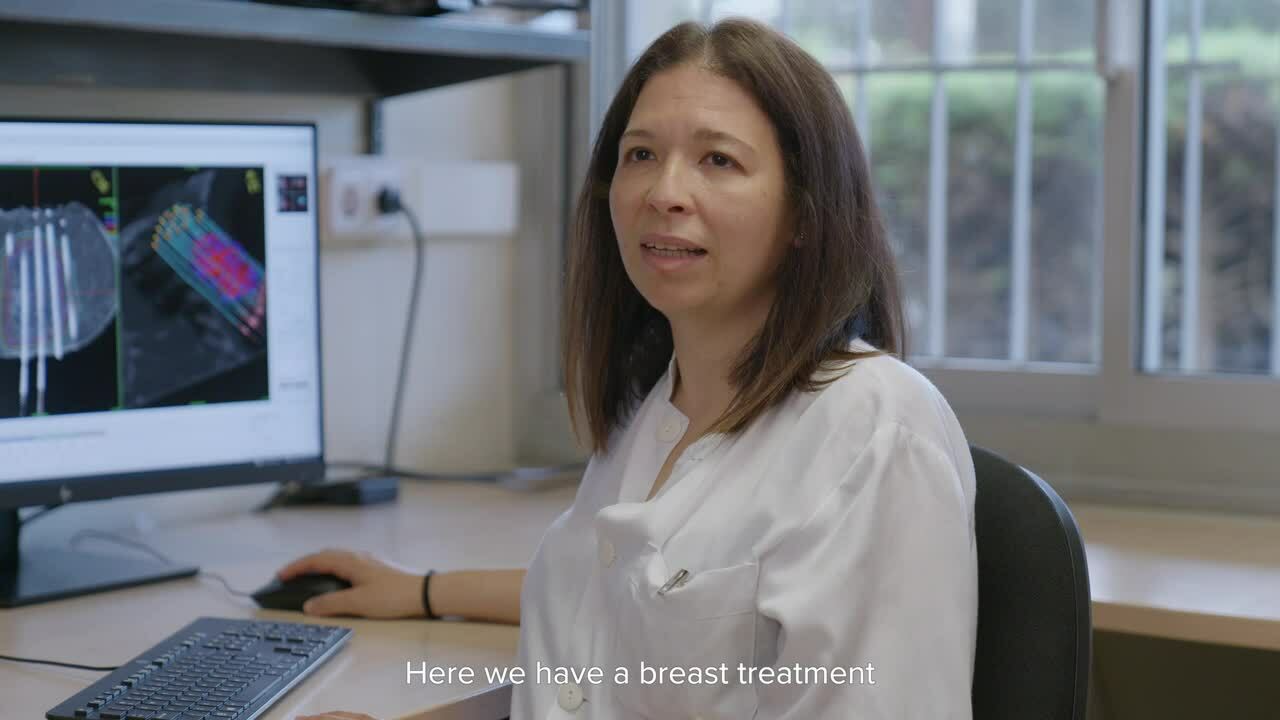
How quality control is achieved in brachytherapy treatments
Healthcare Perspective
Physicist Ruth
Ruth is a Dosimetrist in the Physics Department of ICO Hospitalet - Hospital Duran i Reynals in Barcelona. In this video, she discusses her role in achieving quality controls in brachytherapy treatments.
Ruth works as a dosimetrist in the Physics Department of the hospital. Her primary responsibility entails conducting meticulous quality controls for brachytherapy procedures, executing precise dosimetry measurements, and ultimately administering treatments to patients.

What is brachytherapy treatment?
Brachytherapy is a form of internal radiation therapy to treat cancers. Radioactive materials are placed directly within or near the tumor site. Treating cancer with this technique allows to the administration of a precise dose of radiation to cancer cells while minimizing exposure to the surrounding healthy tissue.
Brachytherapy can be categorized as either permanent brachytherapy or temporary brachytherapy, depending on the duration of time that the radioactive sources remain in the tumor.
Low-dose rate brachytherapy delivers radiation at a slower rate over an extended period, typically over several hours or days. High-dose-rate brachytherapy, on the other hand, delivers a higher dose of radiation at a faster rate, typically in a fraction of minutes.
Brachytherapy can be performed alone or combined with other cancer treatments.
What is dosimetry?
Dosimetry is a method of measuring radiation doses to cancer patients receiving radiotherapy treatment.
Dosimetry plays a crucial role in brachytherapy by ensuring that the radiation dose delivered to the tumor is accurate and in line with the prescribed treatment plan. Dosimetrists like Ruth meticulously calculate and measure the radiation dose distribution to ensure that it conforms to the physician's intended goals. They use advanced techniques and tools to assess the radiation levels at specific points within the patient's body, ensuring the treatment is effective and safe.
Ruth's role as a dosimetrist
Ruth shares that the most rewarding aspect of her role is to be actively involved in every step of the treatment protocol. From the moment a patient's CT scan is retrieved, she takes charge of the dosimetry process and subsequently administers their treatments throughout all the sessions.
"This overall involvement allows me to ensure the continuity and quality of care from start to finish."
Accurate dosimetry is essential to achieve optimal tumor control while minimizing the risk of radiation-related complications.
Empowering Precision in Cancer Treatment through Dosimetry Expertise
Using CT scans and sometimes MRI and PET scanners, Medical Dosimetrists design an individualized plan of treatment for cancer patients who have been prescribed radiation therapy by their oncologist.
Ruth gives us an example of breast cancer treatment with brachytherapy.
She emphasizes the importance of accurately reconstructing the images of the tubes used in brachytherapy, as they must replicate precisely how they are positioned inside the patient. This meticulous reconstruction enables accurate treatment positions that result in optimal dose distribution, ensuring effective and targeted radiation therapy.
Dosimetrists work closely with radiation oncologists and medical physicists to design treatment plans that maximize the therapeutic benefits while minimizing potential side effects.
After achieving optimal dosimetry, Ruth's next step is to notify both the physicist and the radiation oncologist for their evaluation. Upon receiving their approval, she proceeds with conducting an X-ray to execute quality control checks on the treatment. Once the quality control is successfully completed, she proceeds to administer the treatment to the patient.
Ruth is a vital member of the radiation oncology team as she performs calculations to accurately deliver the radiation oncologist's prescribed dose, documents pertinent information in the patient record, and verifies the mathematical accuracy of all calculations.
Ensuring Safe and Effective Treatment: Ruth's Role in Quality Assurance and Support in Radiation Oncology
Before the treatment plan can be executed, the radiation oncology team members work together to perform rigorous quality assurance checks to ensure that the treatment plan is safe and effective. Ruth will communicate the patient’s treatment plan to the radiation therapists by providing field arrangements, beam modification devices, and any concerns that may arise during the treatment planning phase. She often performs or assists the medical physicist with radiation measurements, including ion chamber, thermoluminescent dosimeters (TLD), or film measurement. Ruth also provides technical and physics support for quality assurance and safety. This support entails radiation protection, qualitative machine calibrations, and/or quality assurance of the radiation oncology equipment.
